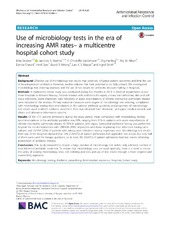| dc.contributor.author | Skodvin, Brita | en_US |
| dc.contributor.author | Wathne, Jannicke Slettli | en_US |
| dc.contributor.author | Lindemann, Paul Christoffer | en_US |
| dc.contributor.author | Harthug, Stig | en_US |
| dc.contributor.author | Nilsen, Roy Miodini | en_US |
| dc.contributor.author | Charani, Esmita | en_US |
| dc.contributor.author | Syre, Heidi | en_US |
| dc.contributor.author | Kittang, Bård Reiakvam | en_US |
| dc.contributor.author | Kleppe, Lars Kåre Selland | en_US |
| dc.contributor.author | Smith, Ingrid | en_US |
| dc.date.accessioned | 2019-08-16T15:08:16Z | |
| dc.date.available | 2019-08-16T15:08:16Z | |
| dc.date.issued | 2019-02-04 | |
| dc.Published | Skodvin B, Wathne JS, Lindemann PC, Harthug S, Nilsen RM, Charani E, Syre H, Kittang BR, Kleppe LK, Smith I. Use of microbiology tests in the era of increasing AMR rates- a multicentre hospital cohort study. Antimicrobial Resistance and Infection Control. 2019;8:28:1-8 | eng |
| dc.identifier.issn | 2047-2994 | |
| dc.identifier.uri | https://hdl.handle.net/1956/20685 | |
| dc.description.abstract | Background: Effective use of microbiology test results may positively influence patient outcomes and limit the use of broad-spectrum antibiotics. However, studies indicate that their potential is not fully utilized. We investigated microbiology test ordering practices and the use of test results for antibiotic decision-making in hospitals. Methods: A multicentre cohort study was conducted during five months in 2014 in Medical departments across three hospitals in Western Norway. Patients treated with antibiotics for sepsis, urinary tract infections, skin and soft tissue infections, lower respiratory tract infections or acute exacerbations of chronic obstructive pulmonary disease were included in the analysis. Primary outcome measures were degree of microbiology test ordering, compliance with microbiology testing recommendations in the national antibiotic guideline and proportion of microbiology test results used to inform antibiotic treatment. Data was obtained from electronic- and paper medical records and charts and laboratory information systems. Results: Of the 1731 patient admissions during the study period, mean compliance with microbiology testing recommendations in the antibiotic guideline was 89%, ranging from 81% in patients with acute exacerbations of chronic obstructive pulmonary disease to 95% in patients with sepsis. Substantial additional testing was performed beyond the recommendations with 298/606 (49%) of patients with lower respiratory tract infections having urine cultures and 42/194 (22%) of patients with urinary tract infections having respiratory tests. Microbiology test results from one of the hospitals showed that 18% (120/672) of patient admissions had applicable test results, but only half of them were used for therapy guidance, i.e. in total, 9% (63/672) of patient admissions had test results informing prescription of antibiotic therapy. Conclusions: This study showed that despite a large number of microbiology test orders, only a limited number of tests informed antibiotic treatment. To ensure that microbiology tests are used optimally, there is a need to review the utility of existing microbiology tests, test ordering practices and use of test results through a more targeted and overarching approach. | en_US |
| dc.language.iso | eng | eng |
| dc.publisher | BMC | eng |
| dc.relation.ispartof | <a href="http://hdl.handle.net/1956/20869" target="blank">Addressing the threat of AMR in Norway: optimising antibiotic prescribing and microbiology testing in hospitals</a> | |
| dc.rights | Attribution CC BY | eng |
| dc.rights.uri | http://creativecommons.org/licenses/by/4.0/ | eng |
| dc.subject | Microbiology testing | eng |
| dc.subject | Antibiotic prescribing | eng |
| dc.subject | Antimicrobial resistance | eng |
| dc.subject | Hospitals | eng |
| dc.subject | Cohort study | eng |
| dc.title | Use of microbiology tests in the era of increasing AMR rates- a multicentre hospital cohort study | en_US |
| dc.type | Peer reviewed | |
| dc.type | Journal article | |
| dc.date.updated | 2019-05-24T11:14:06Z | |
| dc.description.version | publishedVersion | en_US |
| dc.rights.holder | Copyright The Author(s) 2019 | |
| dc.identifier.doi | https://doi.org/10.1186/s13756-019-0480-z | |
| dc.identifier.cristin | 1693320 | |
| dc.source.journal | Antimicrobial Resistance and Infection Control | |

